



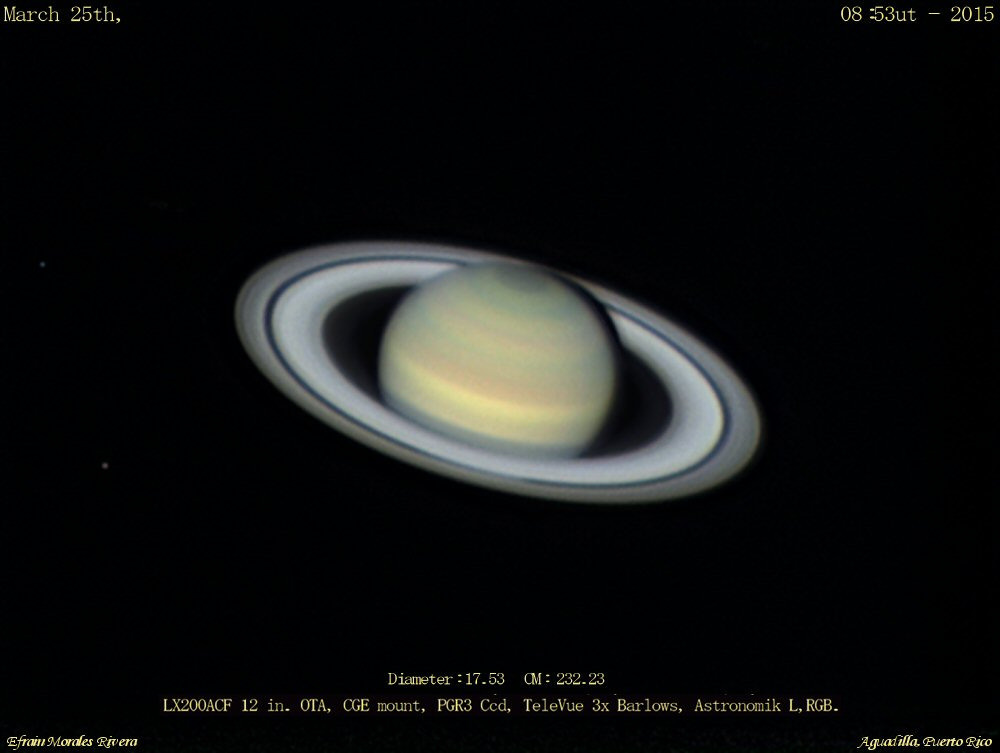
Getting closer… Saturn as seen on March 25th, 2015. Image credit and copyright: Efrain Morales
NASA's Saturn's mission page
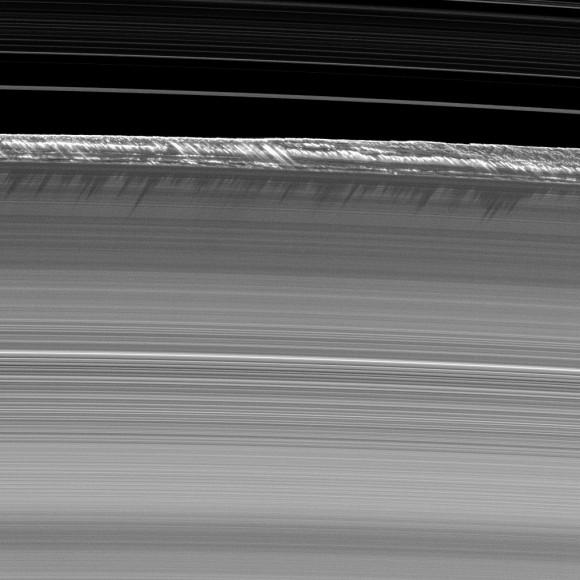

Vertical structures cause shadows on Saturn�s B ring in this July 2009 picture from the Cassini spacecraft.
Credit: NASA/JPL/Space Science Institute
From a distance, Saturn�s rings look like a sheer sheet, but peer up close and you can see that impression is a mistake.
Shadows from rubble believed to be two miles (3.2 kilometers) high are throwing shadows upon the planet�s
B ring in this image from the Cassini spacecraft.
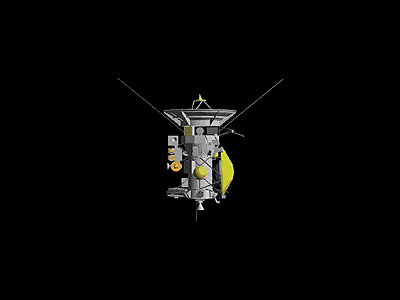
Artist's impression of Cassini-Huygens The Cassini-Huygens spacecraft is one of the largest, heaviest and most complex interplanetary spacecraft ever built.
Of all interplanetary spacecraft, only the two Phobos spacecraft sent to Mars by the former Soviet Union were heavier.
Loaded with an array of powerful instruments and cameras, the spacecraft is capable of taking accurate measurements and detailed
images in a variety of atmospheric conditions and light spectra.

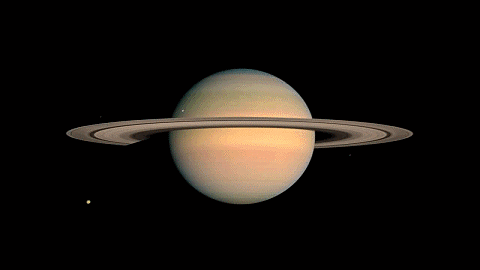
iPhone cameras are good � but they aren't as good as this.
NASA's Cassini spacecraft captured this view as it approached Saturn in early 2011.
The GIF is so beautiful that it's bubbled back up to the front page of Reddit today!

Although Dione (near) and Enceladus (far) are composed of nearly the same materials,
Enceladus has a considerably higher reflectivity than Dione.
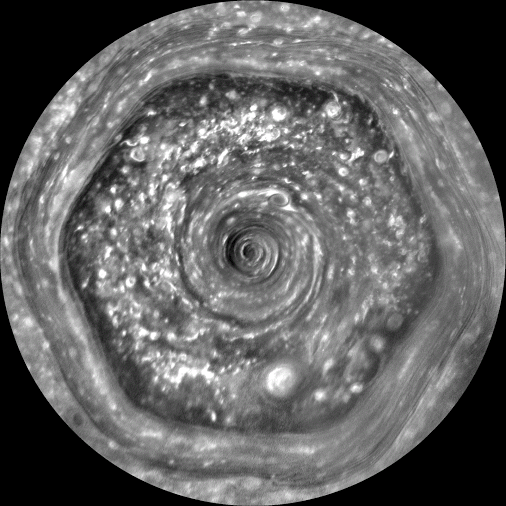
In a paper published in the journal Nature Geoscience (June 15th 2015), atmospheric scientists at MIT have proposed a mechanism
for Saturn’s polar cyclones.
Over time, small, short-lived thunderstorms across the planet are thought to build up angular momentum (or spin) within the atmosphere,
ultimately stirring up a long-lasting vortex at the poles.
Simulations carried out by Morgan O’Neill and colleagues at MIT’s Department of Earth, Atmospheric and Planetary Sciences (EAPS)
show that small isolated thunderstorms pull material in Saturn's atmosphere towards the poles, accumulating atmospheric energy which
then generates a much larger, long-lasting polar cyclone.
The research concludes that whether or not a polar cyclone forms depends on the total energy within a planet’s atmosphere,
and the average size of its thunderstorms, relative to the size of the planet. Larger thunderstorms are more likely to ultimately create the north polar cyclone that has been observed by NASA's Cassini spacecraft orbiting Saturn. Cassini Image Credit : NASA/JPL-Caltech/Space Science Institute.

This colorful view from NASA's Cassini mission is the highest-resolution view of the unique six-sided jet stream
at Saturn's north pole known as "the hexagon." This movie, made from images obtained by Cassini's imaging cameras,
is the first to show the hexagon in color filters, and the first movie to show a complete view from the north pole down
to about 70 degrees north latitude.
IF IT WASN’T ALREADY STRANGE ENOUGH, NOW SATURN’S HEXAGON STORM IS CHANGING COLOR

Saturn makes a beautifully striped ornament in this natural-color image, showing its north polar hexagon and central vortex
(Credit: NASA/JPL-Caltech/Space Science Institute)

Natural color images taken by NASA’s Cassini wide-angle camera, showing the changing appearance
of Saturn’s north polar region between 2012 and 2016..
Credit: NASA/JPL-Caltech/Space Science Institute/Hampton University

This image of Saturn's southern polar vortex reveals previously unseen detail of the giant storm.
Image: NASA/JPL/Space Science Institute

These two previously released infrared images of Saturn show the entire south polar region
with the hurricane-like vortex in the center. The top image shows the polar region in false color,
with red, green, and blue depicting the appearance of the pole in three different near-infrared colors
(NASA/JPL/University of Arizona)

Saturn's F Ring: billions of icy particles strung into ropy filaments by the gravity of small
shepherd moons, and set aglow by sunlight. This sequence of images was captured by Cassini on February 14, 2013.
I've removed some of the visual noise caused by cosmic rays hitting the imaging sensor.
NASA/JPL/Space Science Institute/Bill Dunford Copyright holder: Bill Dunford

The Present position of Cassini
Looking down on cassini:

Cassini Pictures Of Saturn And Its Moons
Published on Nov 20, 2015 341,805 images taken by Cassini's Imaging Science Subsystem (ISS) from the Saturn EDR Data Sets (Volumes 1-93).
This includes all of Cassini's Photos from February 6, 2004 - September 15, 2015.
Compiled and processed by The Wall Street Journal’s @JonKeegan.
NOTE: These raw, unedited sequences at times include rapid flashing. If you have photosensitive epilepsy,
or a similar condition, this could trigger a physical reaction. Please use caution when watching this footage. See more News & Politics License Standard YouTube License

Image: Cassini crosses Saturn’s F ring once on each of its 20 Ring-Grazing Orbits, shown here in tan and lasting from late November 2016 to April 2017. Blue represents the extended solstice mission orbits, which precede the ring-grazing phase. Credit: JPL. That grazing will include two passes directly through a tenuous ring created by meteor strikes on the small moons Janus and Epimetheus. Each orbit will cross the ring plane just outside the F ring, considered to be the boundary of the main ring system, with Cassini actually moving through the outer edges of the F ring in April. Here the science should be particularly interesting — the 800-kilometer wide F ring is malleable, developing and dispersing filament-like structures, dark channels and streamers over short periods of time.

Image: Saturn’s rings were named alphabetically in the order they were discovered. The narrow F ring marks the outer boundary of the main ring system. Credit: NASA/JPL-Caltech/Space Science Institute. The distances involved in this phase of the mission are worth noting. The new orbits will take the craft within 90,000 kilometers of the planet’s cloud tops, but the Grand Finale phase, scheduled to begin next April, closes to within 1628 kilometers. This should be breathtaking, for the craft will move again and again through the gap between Saturn and the rings before making its final plunge into the atmosphere on September 15. Preparations for this final phase begin with a main engine burn on December 4. This is an engine that has served us well — this will be its 183rd burn — but the remainder of the mission will be handled with thrusters.

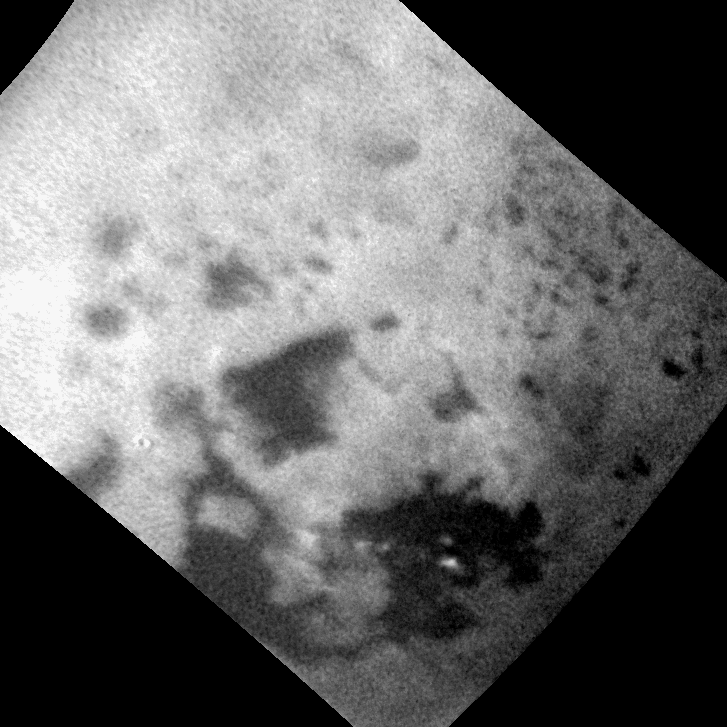
Spacecraft Stormchasing: Titan Clouds Swirl As Saturn Moon Approaches Northern Summer
Clouds swirl on the Saturn moon Titan, over the methane Ligeia Mare, in this picture sequence
taken by the Cassini spacecraft. Credit: NASA/JPL-Caltech/Space Science Institute
Swoosh! At long last, and later than models predicted, clouds are starting to appear
on Titan�s nothern hemisphere. The region is just starting to enter a seven-year-long summer,
and scientists say this could be an indication of coming summer storms there.
by Elizabeth Howell on August 12, 2014

Titan's South Polar Vortex in Motion |
Image credit: NASA/JPL-Caltech/Space Science Institute
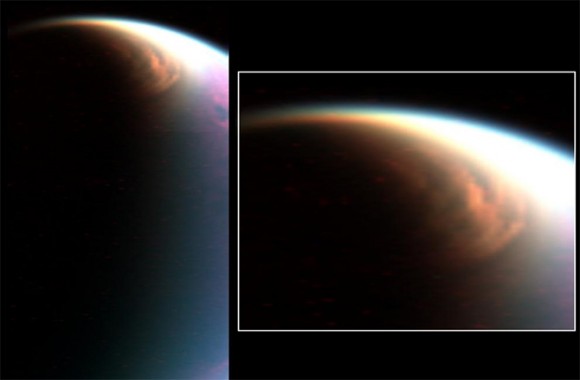
The cloud in the stratosphere over Titan�s north pole (left), Earth�s polar stratospheric clouds (right).
Image Credit: NASA/JPL/UofAriz./LPGNantes; R. NASA/GSFC/M. Schoeberl
During it�s 2006 flyby of Titan, the Cassini Space Probe captured some of the most detailed images of Saturn�s largest moon.
Amongst them was one showing the lofty cloud formations over Titan�s north pole (shown above).
Interestingly enough, these cloud formations bear a strong resemblance to those that are seen in Earth�s own polar stratosphere.
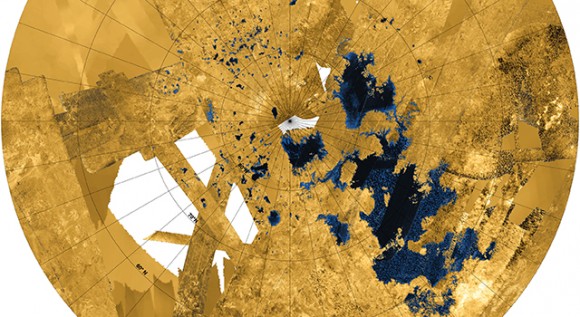
This colorized mosaic from NASA�s Cassini mission shows the most complete view yet of Titan�s northern land of lakes and seas.
Saturn�s moon Titan is the only world in our solar system other than Earth that has stable liquid on its surface.
The liquid in Titan�s lakes and seas is mostly methane and ethane.
Image credit: NASA/JPL-Caltech/ASI/USGS
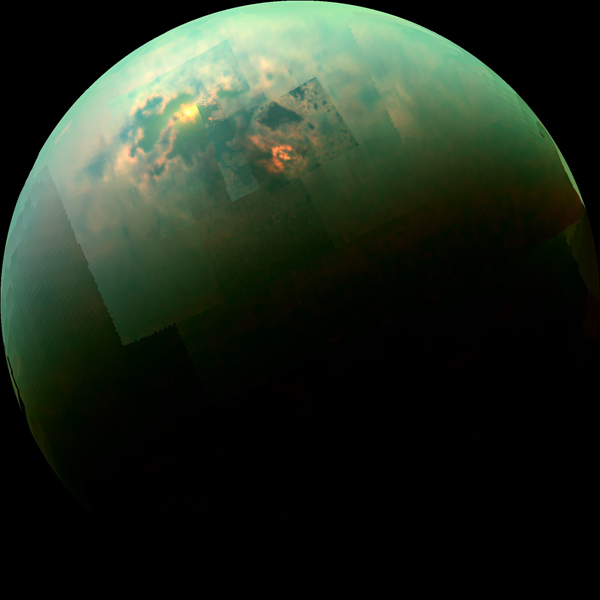
This near-infrared, color mosaic from NASA's Cassini spacecraft shows the sun glinting off of Titan's north polar seas.
While Cassini has captured, separately, views of the polar seas (see PIA17470) and the sun glinting off of them (see PIA12481 and PIA18433)
in the past, this is the first time both have been seen together in the same view.

Image: NASA/JPL/University of Arizona/University of Idaho This composite infra red image of Saturn’s moon Titan was taken on 13 November by NASA’s Cassini probe.
The spacecraft’s visual and infrared mapping spectrometer (VIMS) instrument made these observations,
in which blue represents wavelengths centered at 1.3 microns, green represents 2.0 microns, and red represents 5.0 microns.
A view at visible wavelengths (centered around 0.5 microns) would show only Titan’s hazy atmosphere. The near-infrared wavelengths
in this image allow Cassini’s vision to penetrate the haze and reveal the moon’s surface.
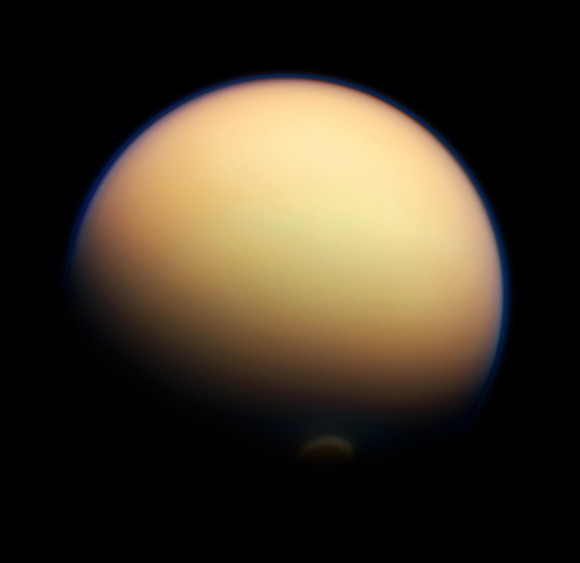
Titan�s surface is almost completely hidden from view by its thick orange �smog�
(NASA/JPL-Caltech/SSI. Composite by J. Major)
Titan is Saturn�s largest moon and is constantly surprising scientists as the Cassini
spacecraft probes under its thick atmosphere. Take its dunes, for example, which are huge and pointed the wrong way.
Why are they pointing opposite to the prevailing east-west winds? It happens during
two rare wind reversals during a single Saturn year (30 Earth years), investigators suggest.
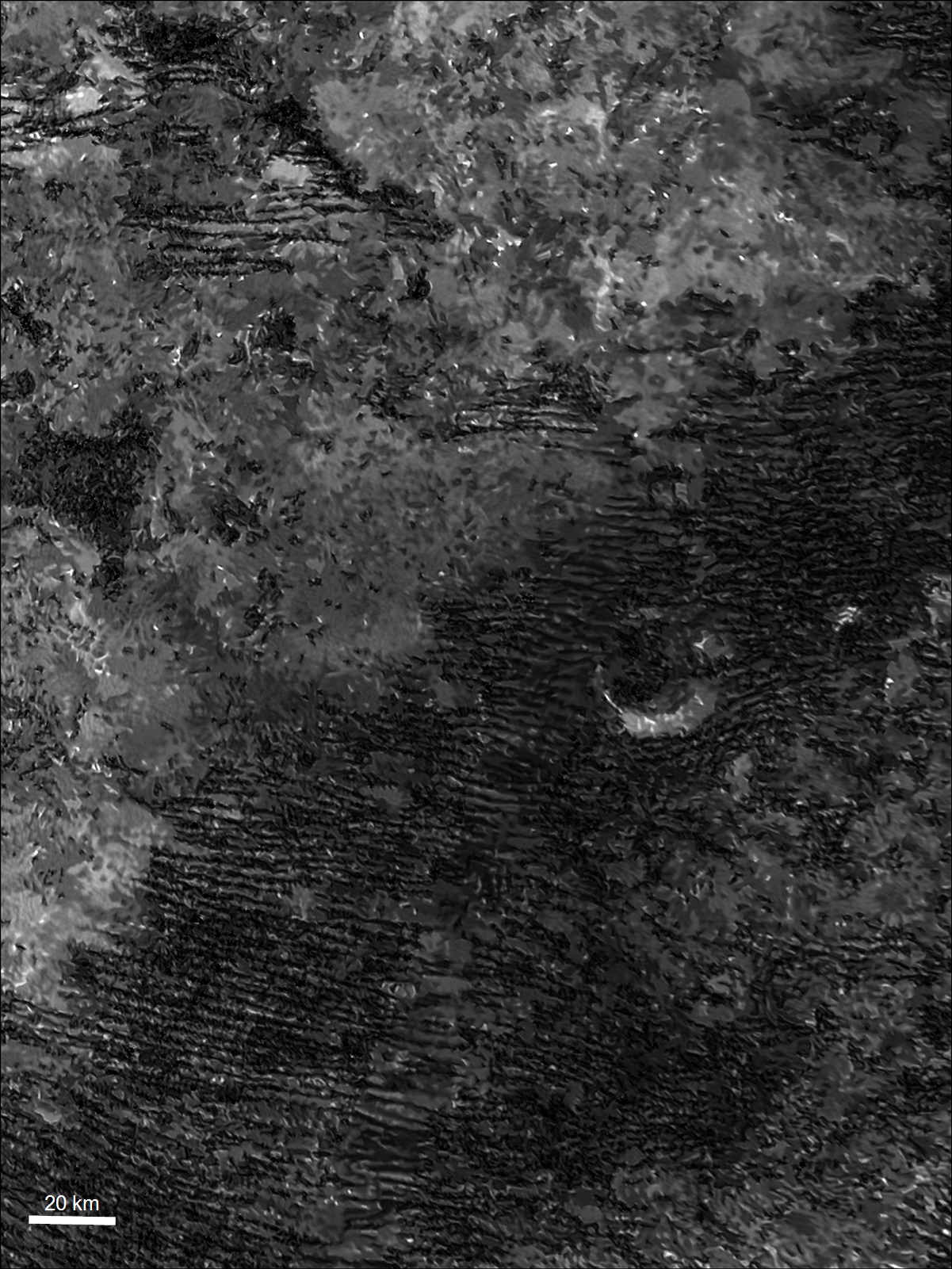
Sand dune patterns on the surface of Titan, seen in a radar image taken by the Cassini spacecraft.
Two groups of researchers are investigating the forces responsible for forming the dunes.
Credit: Cornell/Laboratoire AIM Paris-Diderot
Another group of researchers investigated the formation of Titan's dunes using data from the Cassini spacecraft.
Their work suggests that the dunes may have taken as long as 3,000 Saturn years to form (the equivalent of 90,000 Earth years).
According to a statement from Texas A&M, the formation of the dunes may be influenced by changes in Saturn's orbit.
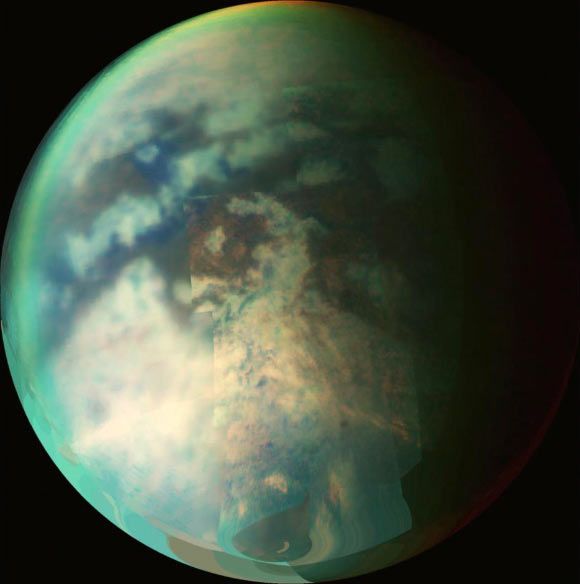
Cassini Sees Rigid, Weathered Ice Shell on TITAN. New gravity & topography data from Cassini
reveal unexpected features of the Titan�s outer ice shell. This image is a composite of several images
taken during two separate Titan flybys on 10/9 & 10/25/2004. Credit: NASA /JPL /U of AZ

Sand dunes and mega-yardangs on Titan. Credit: NASA/JPL-Caltech/ASI/ESA

NASA / JPL / SSI / Emily Lakdawalla Titan geography around Fensal-Aztlan

Artist's concept of an inflatable airship cruising through the skies of Saturn's huge moon Titan. Aerospace firms Northrop Grumman and L'Garde have been developing a Venus-specific version of this vehicle called VAMP (short for Venus Atmospheric Maneuverable Platform). Credit: Northrop-Grumman - : See more

NASA's Cassini spacecraft pinged the surface of Titan with microwaves, finding that some channels are deep, steep-sided canyons
filled with liquid hydrocarbons. One such feature is Vid Flumina, the branching network of narrow lines in the upper-left quadr NASA
just announced that it has discovered flooded canyons on Saturn's moon Titan, a world famous for vast seas and lakes as well as
torrential downpours of methane and other hydrocarbons. The findings, recently published in the journal Geophysical Research Letters,
suggest complex and diverse geologic activity on the distant moon similar to what we have on Earth, despite the substantial differences
between the two worlds.

Cassini image of the northern polar area of Titan and Vid Flumina drainage basin, showing Ligeia Mare (left)
and the Vid Flumina drainage basin (right). Credit: R.L. Kirk/NASA/JPL
Published on Mar 25, 2016 In this talk, Author/artist Michael Carroll will explore the bizarre methane-filled seas and soaring dunes of Saturn's largest moon,
Titan. Recent advances in our understanding of this planet-sized moon provide enough information for authors to paint a realistic picture
of this truly alien world. Following his presentation, he will be signing his new science fiction adventure/mystery book,
"On the Shores of Titan's Farthest Sea". "Carroll's descriptions of oily seas and methane monsoons put you in that alien world, front and center…I can imagine future astronauts doing exactly
the kinds of things Mike describes. I wish I could be one of them." Alan Bean, Apollo 12 astronaut. Category Science & Technology License Standard YouTube License
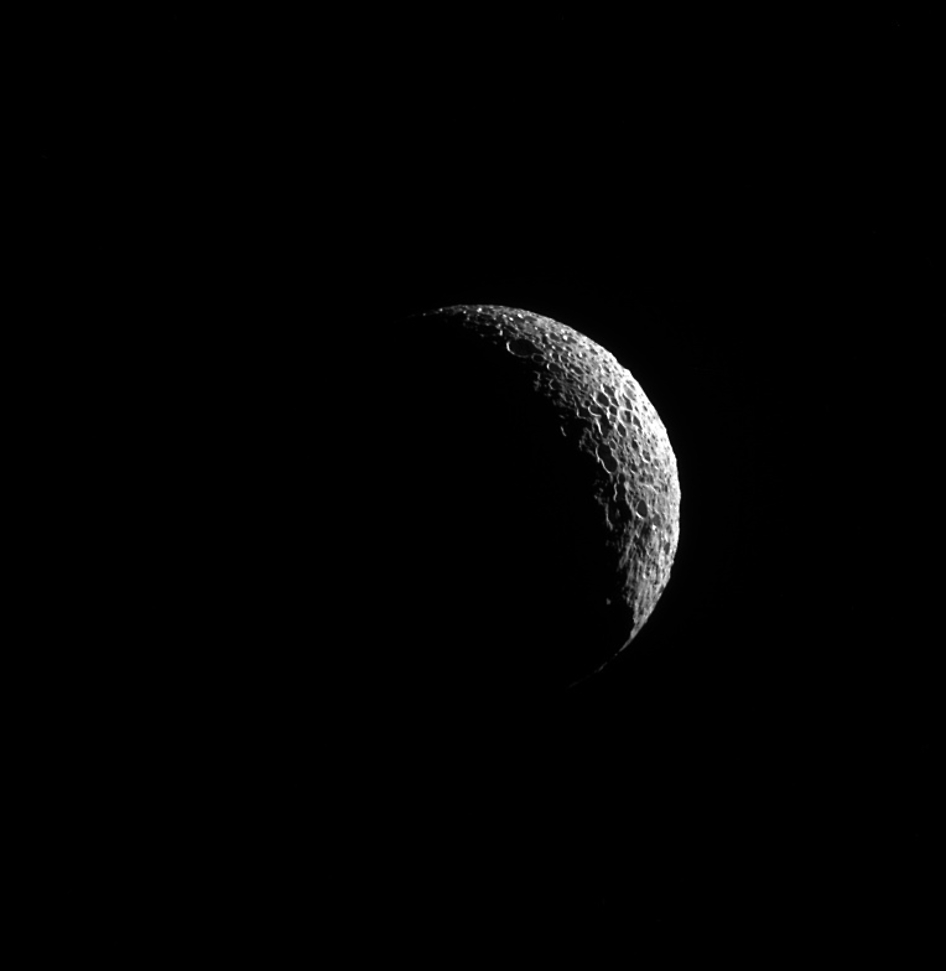
A thin sliver of Mimas is illuminated, the long shadows showing off its many craters,
indicators of the moon's violent history. The most famous evidence of a collision on Mimas (246 miles, or 396 kilometers across)
is the crater Herschel that gives Mimas its Death Star-like appearance. See PIA12568 for more on Herschel.
This view looks toward the anti-Saturn hemisphere of Mimas. North on Mimas is up and rotated 40 degrees to the right.
The image was taken in visible light with the Cassini spacecraft narrow-angle camera on May 20, 2013.
The view was acquired at a distance of approximately 100,000 miles (200,000 kilometers) from Mimas and at a
Sun-Mimas-spacecraft, or phase, angle of 130 degrees. Image scale is 4,000 feet (1 kilometer) per pixel.
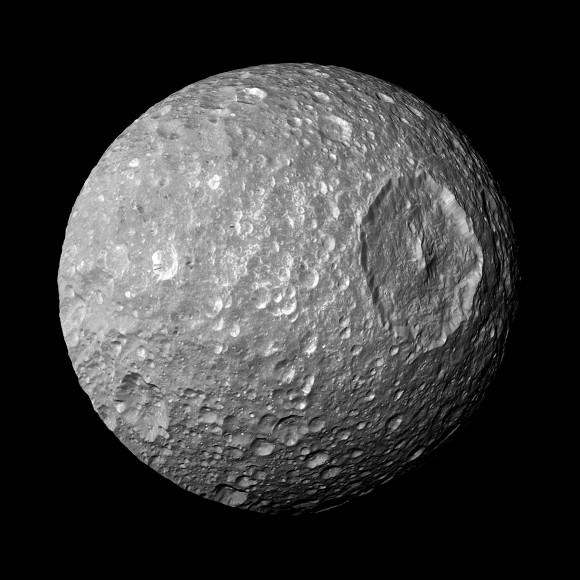
A view of Mimas from the Cassini spacecraft. Credit: NASA/JPL/Space Science Institute
Could there be an ocean hidden somewhere in that Death Star-like picture? This is an image of Mimas, a moon of Saturn,
and just yesterday (Oct. 15) newly released data from the Cassini spacecraft suggests there are big liquid reservoirs underneath its surface.
�The amount of the to-and-fro motion indicates that Mimas� interior is not uniform. These wobbles can be produced
if the moon contains a weirdly shaped, rocky core or if a sub-surface ocean exists beneath its icy shell,� said Cornell University
in a press release. More flybys with the Cassini spacecraft will be required to learn more about what lies beneath.
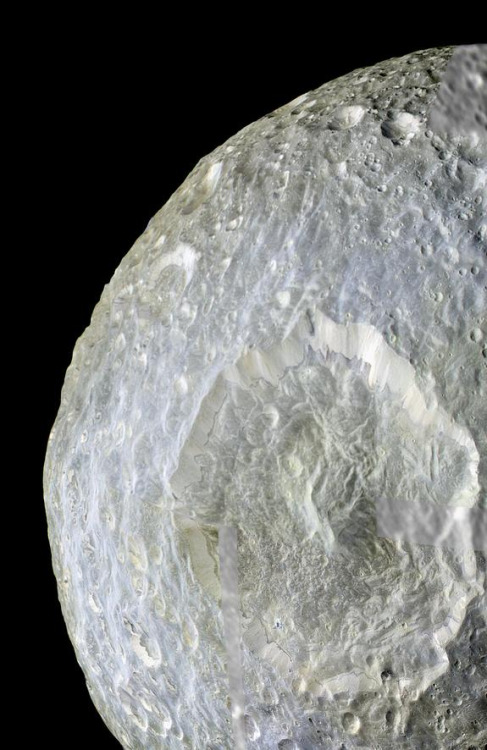
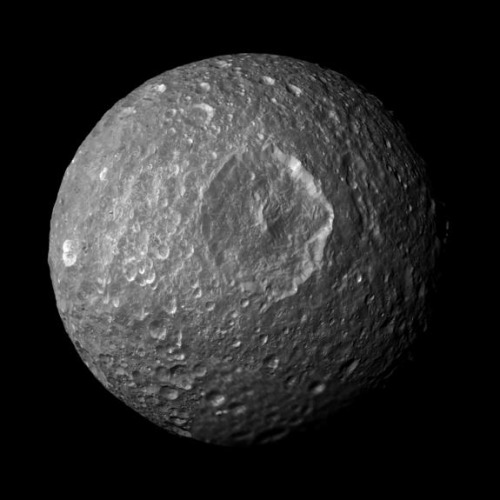

Color map of Mimas, created using data provided by the Cassini spaceprobe. Credit: NASA/JPL/Caltech/SSI/LPI

This figure illustrates the unexpected and bizarre pattern of daytime temperatures found on Saturn’s small inner moon Mimas.
Credit: NASA/JPL/GSFC/SWRI/SSI
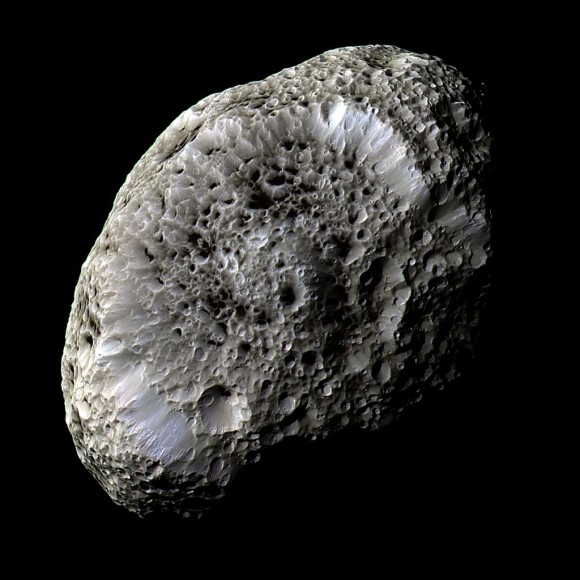
A false-color view of Saturn�s moon Hyperion taken during a Cassini flyby in September 2005.
CREDIT: NASA/JPL-Caltech/Space Science Institute
Ever taken a balloon and rubbed it against your hair? That�s an example of electrostatic charging,
which you see as the balloon briefly attracts strands of hair against your head.
Turns out a similar process is taking place on Saturn�s moon Hyperion. More astounding,
it wasn�t until recently that scientists saw a curious effect on the Cassini spacecraft in 2005.
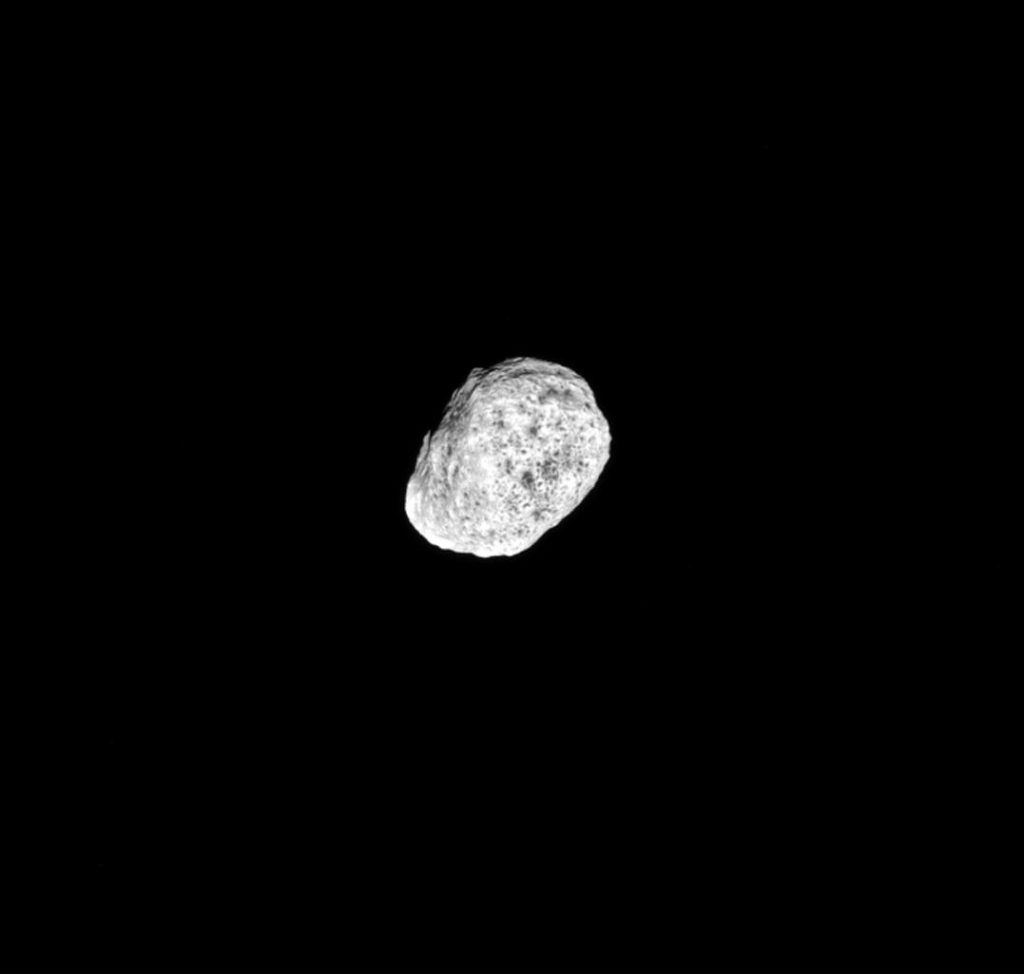
Image: NASA/JPL-Caltech/Space Science Institute. The moon Hyperion tumbles as it orbits Saturn. Hyperion’s (270 kilometres or 168 miles across) spin axis has a chaotic orientation in time, meaning that it is essentially impossible to predict how the moon will be spinning in the future. So far, scientists only know of a few bodies with such chaotic spins. The image was taken in green light with the Cassini spacecraft narrow-angle camera on 22 August 2016.


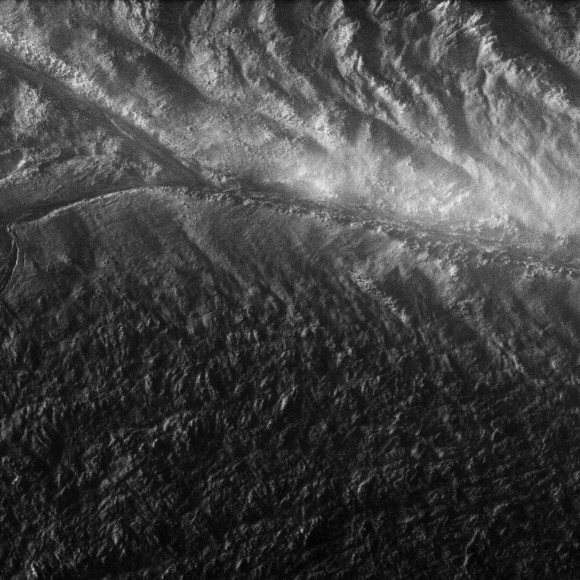
Cassini�s view down into a jetting �tiger stripe� in August 2010. Credit: NASA
Ever since the Cassini space probe conducted its first flyby of Enceladus in 2005,
the strange Saturnian moon has provided us with a treasure trove of images and scientific wonders.
These include the jets of icy water vapor periodically bursting from its south pole, the possibility of an interior ocean �
which may even harbor life � and the strange green-blue stripes located around the south pole.

Published on Oct 27, 2015 Visit for more. NASA's Cassini Spacecraft is about to make a daring plunge through one of the plumes emerging from Saturn's moon Enceladus. Category Science & Technology License Creative Commons Attribution license (reuse allowed) Remix this video Source videos View attributions
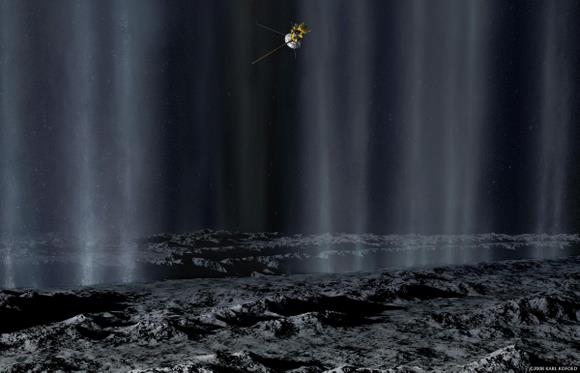
Artist�s impression of the Cassini spacecraft making a close pass by Saturn�s inner moon Enceladus
to study plumes from geysers that erupt from giant fissures in the moon�s southern polar region. Copyright 2008 Karl Kofoed/NASA.
Parcheta�s research recently attracted the attention of visitors to National Geographic�s website,
who voted her #2 in a list of �great explorers� on the Expedition Granted campaign.
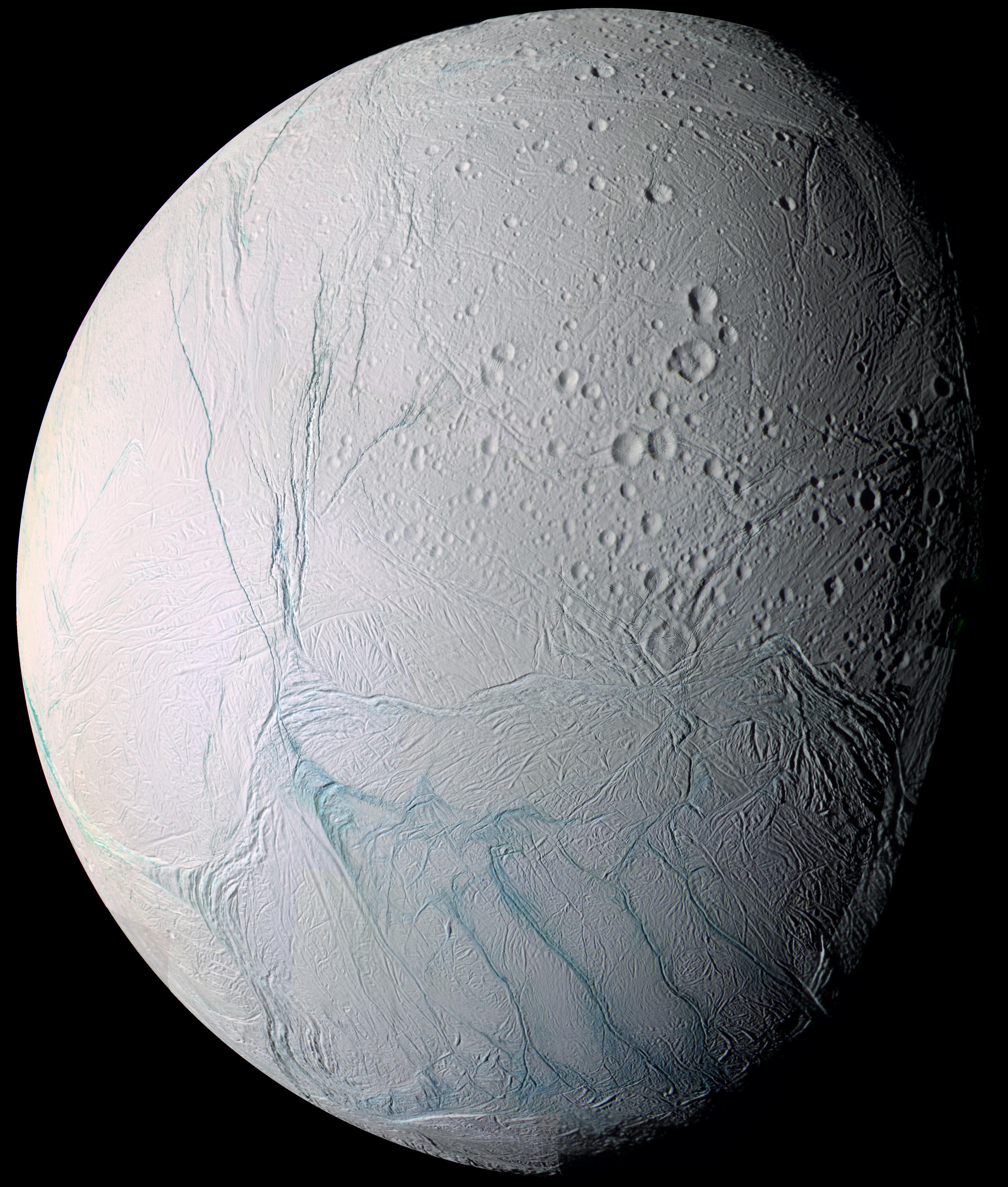
Hot springs on Saturn's icy moon Enceladus suggest that the floor of the satellite's subsurface ocean
may be home to near-boiling temperatures, researchers say.
This finding is the first evidence of active hydrothermal vents beyond the oceans of Earth.
Moreover, conditions deep under the icy surface of Enceladus could be similar to those that gave rise
to the first life on Earth, the researchers reported in the new study.

Craters near Enceladus’ north pole region appear to be ‘melting’ into each other.
Image taken by Cassini spacecraft on October 14, 2015. Credit:
NASA/JPL-Caltech/Space Science Institute

Craters and a possible straight fracture line mar the surface of Enceladus in this raw image
from the Cassini spacecraft taken on October 14, 2015.
Credit: NASA/JPL-Caltech/Space Science Institute.

Craters and fractures dot the landscape of the northern region of Enceladus in this
raw image from the Cassini spacecraft taken on October 14, 2015.
Credit: NASA/JPL-Caltech/Space Science Institute.

A complex region of craters and fractures near the north polar region on Saturn’s moon Enceladus.
Image from Cassini spacecraft taken on October 14, 2015.
Credit: NASA/JPL-Caltech/Space Science Institute

A beautiful view of the night side of a crescent Enceladus, lovingly lit by Saturnshine.
This was captured by the Cassini spacecraft during a close pass on Oct. 14, 2015.
The 6.5-mile-wide Bahman cater is visible near the center.
Credit: NASA/JPL-Caltech/Space Science Institute, image editing by Jason Major.

Enceladus looms into the view of Cassini in this unprocessed Oct 28th image.
Image credit: NASA/JPL Caltech/Space Science Institute

Enceladus vs the rings of Saturn. Image credit: NASA/JPL Caltech/Space Science Institute

Ice geysers ahead, in this Oct 28th view from Cassini.
Image credit: NASA/JPL Caltech/Space Science Institute

A closeup view of the icy terrain of the southern polar region of Enceladus from this weeks’ flyby.
Image credit: NASA/JPL Caltech/Space Science Institute

A high-resolution capture of Enceladus released this weekend by the Cassini team.
The spacecraft was about 60,000 miles (96,000 kilometers) out when this image was taken.
You can see the stark contract of the moon’s fractured cantaloupe terrain, versus craters in the opposite hemisphere imaged.
Credit: NASA/JPL-CalTech/Space Science Institute

NASA's Cassini spacecraft captured this view of Saturn's moon Enceladus that shows wrinkled plains
that are remarkably youthful in appearance, being generally free of large impact craters. When viewed with north pointing up, as in this image, the day-night boundary line (or terminator)
cuts diagonally across Enceladus, with Saturn approaching its northern summer solstice.
The lit portion on all of Saturn's large, icy moons, including Enceladus
(313 miles or 504 kilometers across) and Saturn itself, is now centered on their northern hemispheres.
This change of season, coupled with a new spacecraft trajectory, has progressively revealed new terrains
compared to when Cassini arrived in 2004 (see PIA06547), when the southern hemisphere was more illuminated.
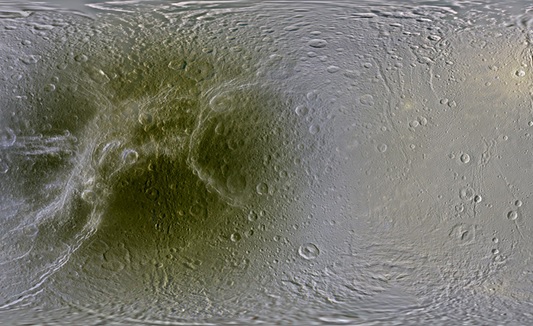
This global map of Dione, a moon of Saturn, shows dark red in the trailing hemisphere, which is due to radiation and charged particles from
Saturn�s intense magnetic environment. Credit: NASA/JPL/Space Science Institute
If you hang out in Saturn�s intense magnetic environment for a while, it�s going to leave a mark.
That�s one conclusion from scientists who proudly released new maps yesterday (Dec. 9)
of the planet�s icy moons, showing dark blotches on the surfaces of Dione, Rhea, and Tethys.
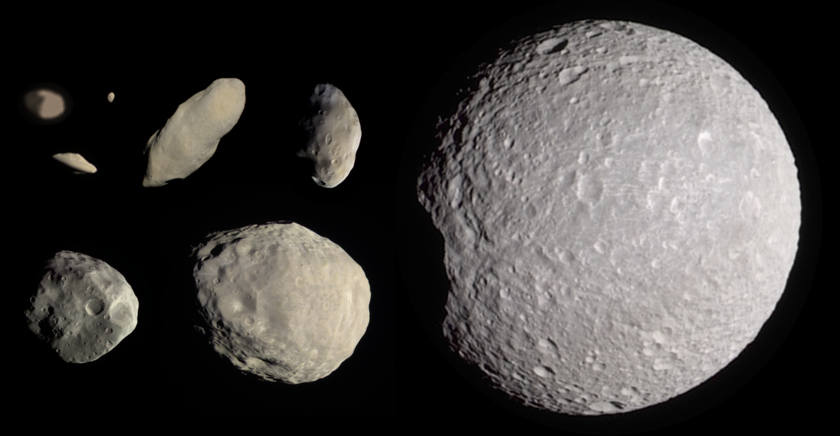
NASA / JPL / SSI / Gordan Ugarkovic / Emily Lakdawalla
Saturn's innermost moons: Pan, Daphnis, Atlas, Prometheus, Pandora, Epimetheus, Janus, and Mimas, to scale
The eight innermost moons of Saturn, in color images collected by Cassini between June 7, 2005, and July 5, 2010.
Pan and Daphnis (top left small moons) orbit within the Encke and Keeler gaps in the rings;
Atlas (below Pan and Daphnis) orbits at the outer edge of the main rings. To their right are Prometheus and Pandora;
Prometheus orbits just inside and Pandora just outside the F ring. Below them are Epimetheus (left) and Janus (right),
which trade positions every four years, averaging out to the same distance from Saturn. Mimas orbits considerably farther away,
but its gravitational effects influence the positions of gaps and waves within the rings.
At full resolution, the montage has a scale of 500 meters per pixel.

uch as its name implies, tiny Epimetheus (Greek for hindsight) was discovered in hindsight.
Astronomers originally thought that Janus and Epithemeus were the same object.
Only later did astronomers realize that there are in fact two bodies sharing the same orbit!
Janus (111 miles or 179 kilometers across) and Epimetheus (70 miles or 113 kilometers)
have the same average distance from Saturn, but they take turns being a little closer or a little farther from Saturn,
swapping positions approximately every 4 years. See PIA08348 for more.
This view looks toward the sunlit side of the rings from about 29 degrees above the ringplane.
The image was taken in visible light with the Cassini spacecraft narrow-angle camera on Jan. 1, 2015.
The view was acquired at a distance of approximately 1.8 million miles (2.9 million kilometers)
from Epimetheus and at a Sun-Epimetheus-spacecraft, or phase, angle of 89 degrees.
Image scale is 11 miles (17 kilometers) per pixel.
The Cassini mission is a cooperative project of NASA, the European Space Agency and the Italian Space Agency.
The Jet Propulsion Laboratory, a division of the California Institute of Technology in Pasadena,
manages the mission for NASA's Science Mission Directorate, Washington, D.C.
The Cassini orbiter and its two onboard cameras were designed, developed and assembled at JPL.
The imaging operations center is based at the Space Science Institute in Boulder, Colo.
For more information about the Cassini-Huygens mission visit
and For more information about the Cassini-Huygens mission visit
AND The Cassini imaging team homepage Credit: NASA/JPL-Caltech/Space Science Institute Last Updated: July 30, 2015 Editor: Tony Greicius

Saturn’s moon Rhea, as imaged by the Cassini-Huygens spacecraft. Credit: NASA/JPL-Caltech

Views of Saturn’s moon Rhea, with false-color image showing elevation data at the right.
Credit: NASA/JPL/Space Science Institute

Hemispheric color differences on Saturn’s moon Rhea are apparent in this false-color view of the anti-Cronian side,
from NASA’s Cassini spacecraft. Image Credit: NASA/JPL/SSI
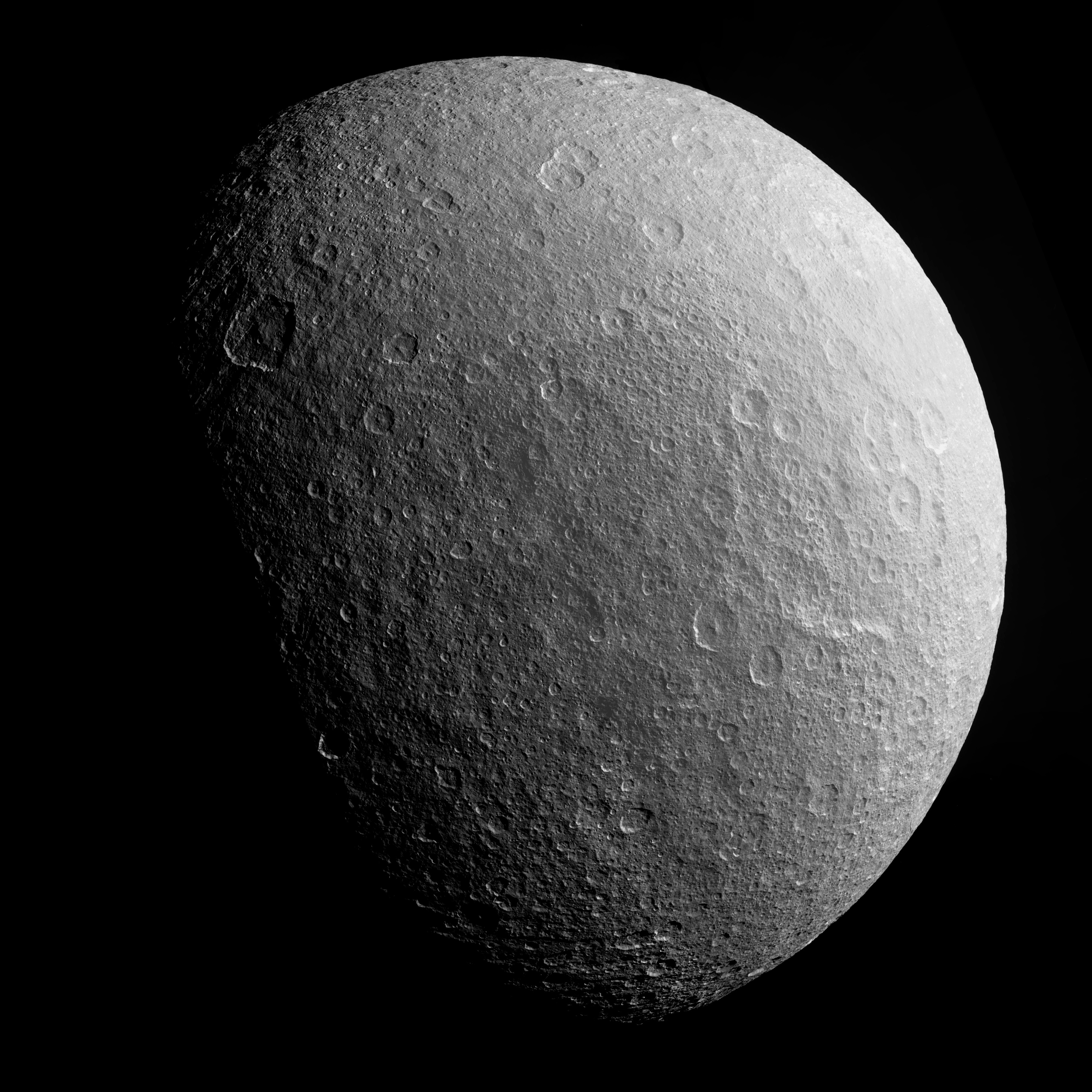
Northern Rhea
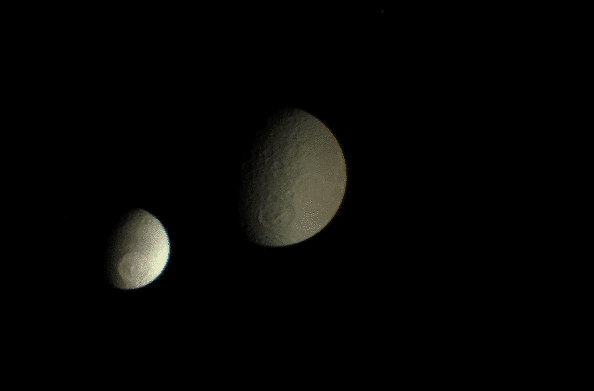
MEETING OF TETHYS AND RHEA
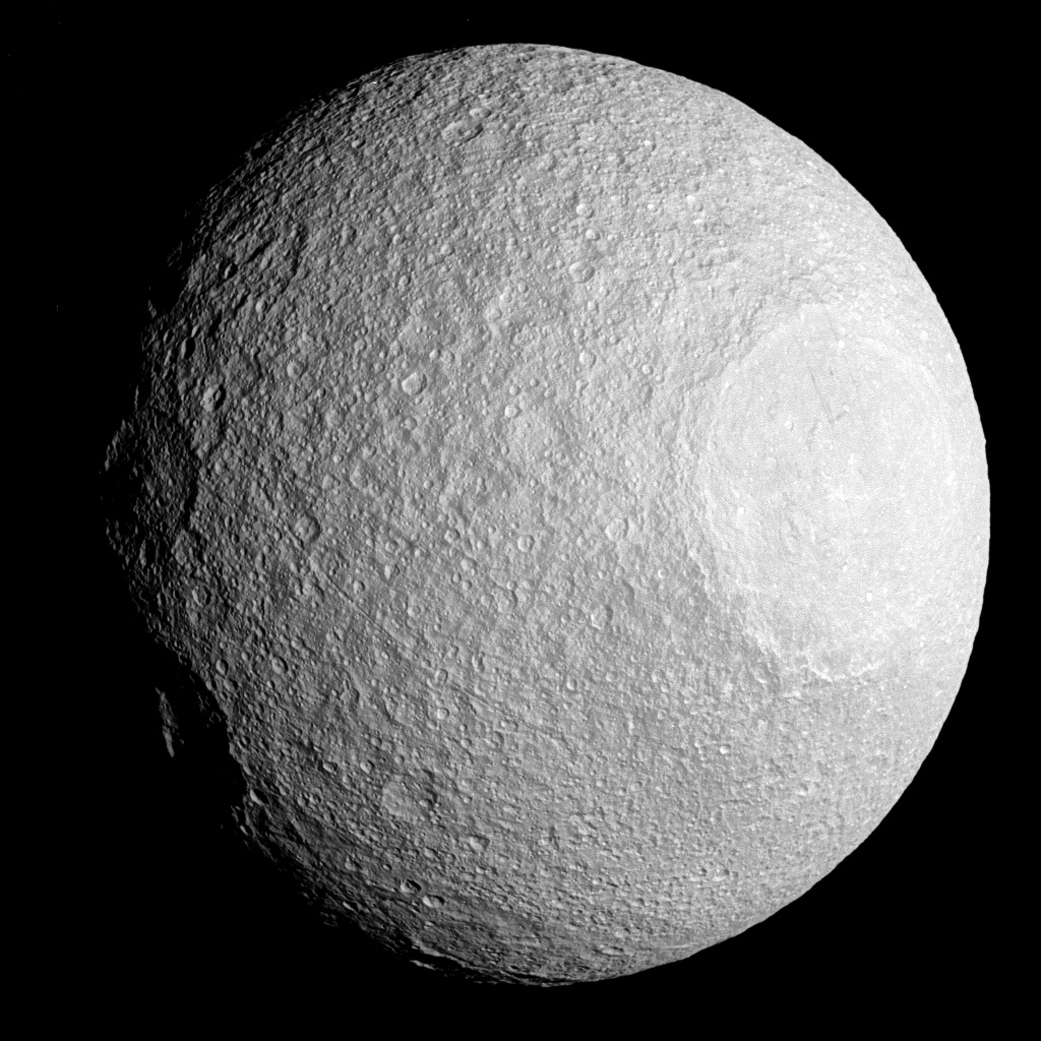
Like most moons in the solar system, Tethys is covered by impact craters.
Some craters bear witness to incredibly violent events, such as the crater Odysseus
(seen here at the right of the image). The image was taken in visible light with the
Cassini spacecraft narrow-angle camera on April 11, 2015.
Bookmark and Share

Enhanced-color image from Cassini showing red streaks on Saturn’s moon Tethys
(Credit: NASA/JPL-Caltech/Space Science Institute)

Ceres (left, Dawn image) compared to Tethys (right, Cassini image) at comparative scale sizes.
(Credits: NASA/JPL-Caltech/UCLA/MPS/DLR/IDA and NASA/JPL-Caltech/SSI. Comparison by J. Major.)

Frozen, airless Tethys
662-mile-wide Tethys, as seen by Cassini on March 3, 2010.
Part of the 1200-mile-long Ithaca Chasma can be seen on its western edge,
running north to south. With a density .97 times that of liquid water, Tethys is almost completely made of ice.
Image has been adjusted to bring out surface details.
Image: NASA/JPL/Space Science Institute

The Odysseus Crater, the 400 km surface feature that gives Tethys it’s “Death Star” appearance. Credit: NASA/JPL/SSI

Cassini closeup of the southern end of Ithaca Chasma. Credit: NASA/JPL/Space Science Institute.

Global, color mosaics of Saturn’s moon Tethys, as produced from images taken by NASA’s Cassini spacecraft between 2004-2014.
Credit: NASA/JPL-Caltech/Space Science Institute/ Lunar and Planetary Institute
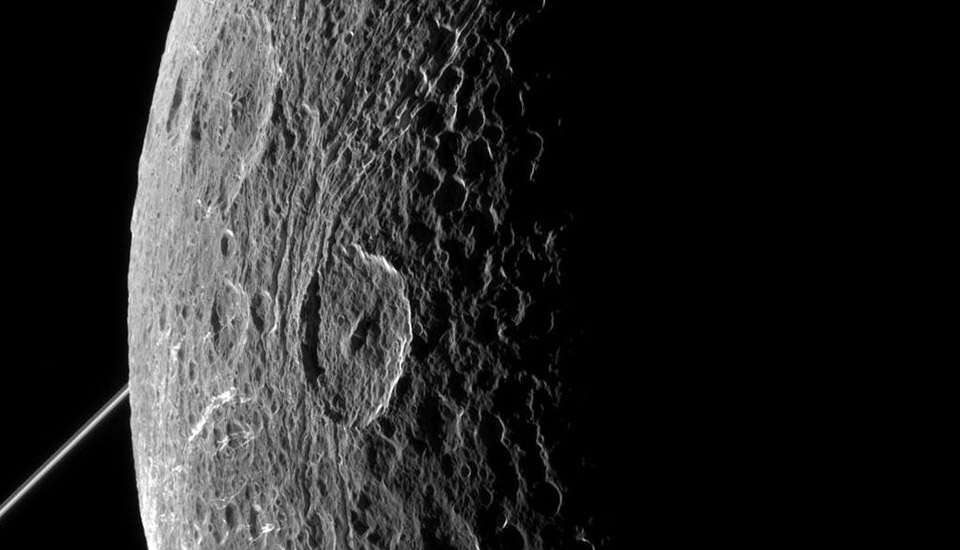
This is a photo of Dione, one of Saturn's moons. Just like the planet's most stunning images,
this picture was also captured by NASA's and ESA's Cassini spacecraft, as it flew by on June 16, 2015.
The vessel, which has been orbiting Saturn for over a decade, took the pictures in visible light
using a narrow-angle camera at an altitude of 321 miles from the moon's pockmarked surface.
While that's pretty close, the closest flyby yet happened in 2011, when Cassini flew by Dione at an altitude of 62 miles.
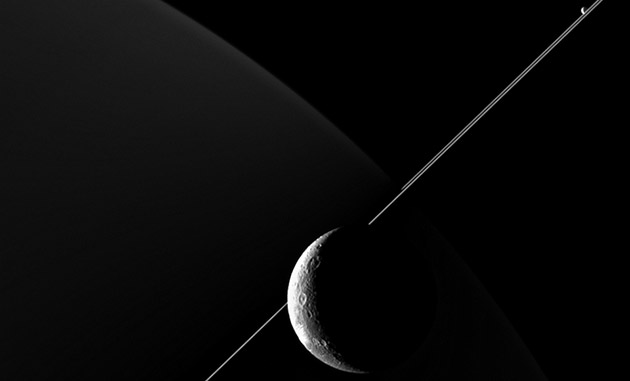
The image above was taken from 48,000 miles away, with Saturn and its rings visible in the background
and Enceladus making a cameo on the upper right portion of the pic. Enceladus is another Saturnian moon,
which astronomers believe might have warm waters, chemicals and minerals that could foster life.
Cassini's slated to pass real close to it soon -- as close as 30 miles from its surface --
and will likely take images of the icy satellite, as well.

A view of Saturn's moon Dione captured by NASA's Cassini spacecraft during a close flyby on June 16, 2015.
The diagonal line near upper left is the rings of Saturn, in the distance.
Image credit: NASA/JPL-Caltech/Space Science Institute

Saturn’s moon Dione, with Saturn’s rings visible in the background. Credit: NASA/JPL

Global map of Dione, showing dark red in the trailing hemisphere (left),
which is due to radiation and charged particles from Saturn’s.
Credit: NASA/JPL/Space Science Institute

Dione’s trailing hemisphere, pictured by the Cassini orbiter, which shows its patches of “wispy terrain”.
Credit: NASA/JPL

Dione viewed by Cassini on October 11th, 2005, showing the Alcander crater (top) and the larger Prytanis crater to its left.
Credit: NASA/JPL/SSI

While not bursting with activity like its system sister Enceladus, the surface of Dione is definitely not boring.
Some parts of the surface are covered by linear features, called chasmata, which provide dramatic contrast to the round impact
craters that typically cover moons. The bright network of fractures on Dione (698 miles or 1123 kilometers across) was seen originally at poor resolution in
Voyager images and was labeled as "wispy terrain." The nature of this terrain was unclear until Cassini showed that they weren't
surface deposits of frost, as some had suspected, but rather a pattern of bright icy cliffs among myriad fractures.
One possibility is that this stress pattern may be related to Dione's orbital evolution and the effect of tidal stresses over time. This view looks toward the trailing hemisphere of Dione. North on Dione is up. The image was taken in visible light with the
Cassini spacecraft narrow-angle camera on April 11, 2015. The view was acquired at a distance of approximately 68,000 miles (110,000 kilometers) from Dione. Image scale is 2,200 feet (660 meters) per pixel. The Cassini mission is a cooperative project of NASA, ESA (the European Space Agency) and the Italian Space Agency.
The Jet Propulsion Laboratory, a division of the California Institute of Technology in Pasadena, manages the mission for NASA's Science Mission
Directorate, Washington. The Cassini orbiter and its two onboard cameras were designed, developed and assembled at JPL.
The imaging operations center is based at the Space Science Institute in Boulder, Colorado. For more information about the Cassini-Huygens mission visit
orFor more information about the Cassini-Huygens mission visit
or The Cassini imaging team homepage
Credit: NASA/JPL-Caltech/Space Science Institute
Last Updated: Aug. 17, 2015 Editor: Tony Greicius

Is Dione (698 miles or 1123 kilometers across) suddenly larger than Rhea (949 miles or 1527 kilometers across)? No, of course not. Cassini simply captured an image
when Dione was much closer to the camera, making the moon appear much bigger than her larger sister moon.
Besides their beauty, images like these can help Cassini's navigators determine exactly where the spacecraft
is and confirm that it's on course.
This view looks toward the trailing hemisphere of Dione. North on Dione is up. The image was taken in visible light with the Cassini
spacecraft narrow-angle camera on April 11, 2015.
The view was obtained at a distance of approximately 68,000 miles (110,000 kilometers) from Dione and at a Sun-Dione-spacecraft,
or phase, angle of 29 degrees. Image scale at Dione is 2,165 feet (660 meters) per pixel. Rhea was 300,000 miles (500,000 kilometers)
away at a phase (Sun-Rhea-spacecraft) angle of 30 degrees. The image scale at Rhea is 2 miles (3 kilometers) per pixel.
The Cassini mission is a cooperative project of NASA, ESA (the European Space Agency) and the Italian Space Agency.
The Jet Propulsion Laboratory, a division of the California Institute of Technology in Pasadena, manages the mission for NASA's
Science Mission Directorate, Washington. The Cassini orbiter and its two onboard cameras were designed, developed and assembled at JPL.
The imaging operations center is based at the Space Science Institute in Boulder, Colorado.
For more information about the Cassini-Huygens mission visit
or For more information about the Cassini-Huygens mission visit
or. The Cassini imaging team homepage is at . Credit: NASA/JPL-Caltech/Space Science Institute Last Updated: July 30, 2015 Editor: Tony Greicius

This artist's concept shows a glowing patch of ultraviolet light near Saturn's north pole that occurs at the "footprint"
of the magnetic connection between Saturn and its moon Enceladus. The footprint and magnetic field lines are not visible to the naked eye,
but were detected by the ultraviolet imaging spectrograph and the fields and particles instruments on NASA's Cassini spacecraft.
The footprint, newly discovered by Cassini, marks the presence of an electrical circuit that connects Saturn with Enceladus and
accelerates electrons and ions along the magnetic field lines. In this image, the footprint is in the white box marked on Saturn,
with the magnetic field lines in white and purple.

Image CREDIT: NASA / JPL-Caltech / Space Science Institute / Cassini. Cassini developed a THEORY about this moon, now known as Iapetus.
He contended that first off, Iapetus must be two-toned, with one side significantly
lighter and brighter than the other, darker side, and that secondly, it must be tidally locked to Saturn,
so that the same side always faces it. Put this together and the “leading edge” of Iapetus
would have to be significantly fainter and darker than the trailing edge. If, that is, Cassini was right.

Image CREDIT: NASA / JPL / Space Science Institute. Iapetus was very much two-toned, with one hemisphere a factor of ten-to-twenty
times more reflective than the other. The situation was even more severe than Cassini
himself had ever imagined, as the delineation between light-and-dark hemispheres doesn’t
perfectly coincide with Iapetus’ orbit.

Enhanced-color map of Iapetus, using data collected by the Cassini probe. The leading hemisphere is at the right.
Credit: NASA/JPL-Caltech/SSI/LPI

Three different false-color views of Saturn’s moon Iapetus, showing the boundary of the global “color dichotomy”.
Credit: NASA/JPL/Space Science Institute

Saturn’s moon Iapetus, captured by the Cassini space probe on New Year’s Eve 2004. Credit: NASA/JPL/Space Science Institute.
Published on Jul 20, 2015 The strangest feature on Iapetus is the equatorial ridge. What could possibly create a feature like this? Support us at: http://www.patreon.com/universetoday More stories at: http://www.universetoday.com/ Follow us on Twitter: @universetoday Follow us on Tumblr: http://universetoday.tumblr.com/ Like us on Facebook: https://www.facebook.com/universetoday Google+ - https://plus.google.com/+universetoday/ Instagram - http://instagram.com/universetoday Team: Fraser Cain - @fcain Jason Harmer - @jasoncharmer Susie Murph - @susiemmurph Brian Koberlein - @briankoberlein Chad Weber - weber.chad@gmail.com Kevin Gill - @kevinmgill Created by: Fraser Cain and Jason Harmer Edited by: Chad Weber Music: Left Spine Down - “X-Ray”

Image CREDIT: English Wikipedia user The Singing Badger. Iapetus, you see, is the outermost large moon of Saturn, orbiting twice
as far out as any of Saturn’s other moons. What appears to be some type of
dark debris that collected on the leading side — an effect similar to “bugs on a windshield”
— would be an awfully bizarre explanation, since it’s well outside of the other major players in Saturn’s system,